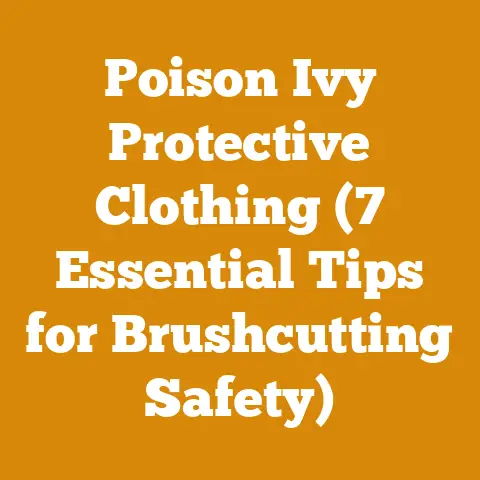Husqvarna Chainsaw Helmets (5 Pro Tips for Optimal Safety)
Guarding Your Grey Matter: 5 Pro Tips for Husqvarna Chainsaw Helmet Safety
As a seasoned woodworker and someone who’s spent countless hours felling trees and processing timber, I can tell you firsthand that safety isn’t just a buzzword – it’s the key to a long and fulfilling career (or hobby) in this demanding field. That’s why, in this guide, I’m diving deep into the world of Husqvarna chainsaw helmets, sharing five pro tips to ensure optimal safety. This isn’t just about meeting regulations; it’s about preserving your well-being so you can continue enjoying the craft you love.
I remember one particularly close call – a seemingly dead branch that snapped back with surprising force. Without my helmet, the story would have ended very differently. It’s experiences like that that have cemented my belief in the absolute necessity of top-notch head protection.
1. The Perfect Fit: Sizing and Adjustment Mastery
A helmet that doesn’t fit properly is as good as no helmet at all. It’s loose, uncomfortable, and won’t provide adequate protection in the event of an impact. A snug, secure fit is paramount.
-
Sizing is Key:
- Measure your head circumference: Use a flexible measuring tape to measure around your head, just above your eyebrows and ears. This measurement will guide you to the correct helmet size. Husqvarna helmets typically come in sizes ranging from Medium (54-59 cm) to Large (59-62 cm). Always refer to the specific model’s sizing chart, as variations can occur.
- Trying it on: When trying on a helmet, ensure it sits level on your head, covering your forehead. There should be no excessive movement when you shake your head.
-
Adjustment Mechanisms:
-
Ratchet Adjustment: Most Husqvarna chainsaw helmets feature a ratchet adjustment system at the back. This allows you to fine-tune the fit for optimal comfort and security. Tighten the ratchet until the helmet feels snug but not overly tight. You should be able to insert one or two fingers between the helmet and your forehead.
- Chin Strap: The chin strap is crucial for keeping the helmet in place during an impact. Adjust the strap so it sits comfortably under your chin without being too loose or too tight. A good rule of thumb is that you should be able to fit two fingers between the strap and your chin.
- Internal Harness: Some models also feature an internal harness system that can be adjusted for height. This allows you to customize the helmet’s fit even further, ensuring it sits properly on your head.
-
Personal Experience: I’ve found that wearing a thin beanie or sweatband under the helmet can improve comfort, especially during hot weather. It also helps to absorb sweat and keep the helmet clean.
2. Beyond the Shell: Understanding Helmet Components
A Husqvarna chainsaw helmet is more than just a hard shell. It’s a complex piece of safety equipment designed to protect you from a variety of hazards. Understanding the different components and their functions is crucial for making an informed purchase and ensuring optimal protection.
-
The Shell:
- Material: Husqvarna helmet shells are typically made from high-density polyethylene (HDPE) or acrylonitrile butadiene styrene (ABS). These materials are chosen for their impact resistance and durability. HDPE is generally more resistant to cracking at lower temperatures, while ABS offers superior scratch resistance.
- Impact Resistance: The shell is designed to absorb and distribute the force of an impact, preventing it from reaching your head. All Husqvarna helmets meet or exceed ANSI Z89.1 Type I, Class C standards, meaning they are designed to protect against impacts from above and provide electrical insulation.
- Data Point: According to ANSI Z89.1, a Type I helmet must withstand an impact of 8 pounds dropped from a height of 5 feet.
-
The Suspension System:
-
Function: The suspension system is the network of straps and padding inside the helmet that cradles your head. It’s designed to absorb and distribute the impact force, reducing the amount of energy transferred to your skull.
- Adjustment: As mentioned earlier, the suspension system is adjustable to ensure a snug and comfortable fit. The ratchet adjustment and internal harness allow you to customize the fit to your head shape and size.
- Material: The suspension system is typically made from nylon or polyester webbing. These materials are strong, durable, and resistant to moisture.
-
The Face Shield:
-
Function: The face shield protects your eyes and face from flying debris, such as wood chips and sawdust. It’s typically made from polycarbonate, a strong and shatter-resistant material.
- Coverage: Look for a face shield that provides ample coverage, extending from your forehead to below your chin. Some models also feature adjustable shields that can be raised or lowered as needed.
- Optical Clarity: Ensure the face shield offers good optical clarity, allowing you to see clearly without distortion. Some models feature anti-fog coatings to prevent fogging in humid conditions.
-
The Ear Protection:
-
Function: Chainsaws are notoriously loud, and prolonged exposure to high noise levels can cause permanent hearing damage. Husqvarna chainsaw helmets typically include integrated ear muffs to protect your hearing.
- Noise Reduction Rating (NRR): The NRR indicates the amount of noise reduction the ear muffs provide. A higher NRR means greater protection. Look for ear muffs with an NRR of at least 25 dB. Some models offer even higher NRR ratings for extreme noise environments.
- Comfort: Ensure the ear muffs are comfortable to wear for extended periods. Look for models with soft, padded ear cups and adjustable headbands.
3. The Lifespan Lie: When to Replace Your Helmet
Chainsaw helmets aren’t designed to last forever. Over time, the materials can degrade due to exposure to sunlight, heat, and chemicals. Even if your helmet looks fine on the surface, it may have hidden damage that compromises its protective capabilities.
-
The “Use-By” Date:
- Manufacturing Date: Most helmets have a manufacturing date stamped inside the shell. This is the starting point for determining the helmet’s lifespan.
- Recommended Replacement: Husqvarna recommends replacing chainsaw helmets every 3-5 years, regardless of their apparent condition. This is because the materials degrade over time, even if the helmet hasn’t been subjected to any impacts.
-
Impact Damage:
-
Immediate Replacement: If your helmet has been subjected to an impact, even a minor one, it should be replaced immediately. The impact may have caused internal damage that is not visible to the naked eye.
- Cracks and Dents: Inspect the helmet shell regularly for cracks, dents, or other signs of damage. Any damage to the shell compromises its ability to protect your head.
-
Environmental Factors:
-
Sunlight and Heat: Prolonged exposure to sunlight and heat can cause the helmet shell to become brittle and crack. Store your helmet in a cool, dry place when not in use.
- Chemical Exposure: Exposure to chemicals, such as gasoline, oil, and solvents, can also damage the helmet shell. Clean your helmet regularly with mild soap and water.
- Personal Anecdote: I once continued to use a helmet that had a minor dent. I thought it was fine, but after doing some research, I realized the potential risks. I immediately replaced it. It’s a small price to pay for peace of mind.
4. Maintaining Your Fortress: Cleaning and Storage Best Practices
Proper maintenance is essential for extending the lifespan of your chainsaw helmet and ensuring it continues to provide optimal protection. Cleaning and storage are two key aspects of helmet maintenance.
-
Cleaning Procedures:
- Mild Soap and Water: Clean your helmet regularly with mild soap and water. Avoid using harsh chemicals or solvents, as these can damage the shell and suspension system.
- Rinse Thoroughly: Rinse the helmet thoroughly with clean water to remove any soap residue.
- Air Dry: Allow the helmet to air dry completely before storing it. Avoid using a hairdryer or other heat source, as this can damage the materials.
- Face Shield Care: Clean the face shield with a soft cloth and a mild cleaner specifically designed for polycarbonate. Avoid using abrasive cleaners, as these can scratch the surface.
-
Storage Guidelines:
-
Cool, Dry Place: Store your helmet in a cool, dry place away from direct sunlight and heat.
- Avoid Compression: Avoid storing heavy objects on top of the helmet, as this can compress the shell and suspension system.
- Protective Bag: Consider storing your helmet in a protective bag to prevent scratches and dust accumulation.
- Temperature Considerations: Avoid storing your helmet in extreme temperatures (below -20°C or above 50°C), as this can damage the materials.
- Technical Detail: According to studies on polymer degradation, prolonged exposure to UV radiation can reduce the impact resistance of HDPE by up to 20% over a 5-year period. This highlights the importance of proper storage to minimize UV exposure.
5. Beyond Compliance: Customization and Comfort Enhancements
While safety is the primary concern, comfort and customization can also play a role in ensuring you wear your helmet consistently and correctly.
-
Ventilation:
- Importance: Good ventilation is essential for keeping your head cool and comfortable, especially during strenuous work.
- Features: Look for helmets with multiple vents that allow air to circulate freely. Some models feature adjustable vents that can be opened or closed depending on the weather conditions.
-
Sweat Management:
-
Sweatband: A sweatband can help to absorb sweat and keep it from dripping into your eyes. Look for helmets with removable and washable sweatbands.
- Moisture-Wicking Fabrics: Consider wearing a moisture-wicking beanie or sweatband under the helmet to further enhance sweat management.
-
Accessories:
-
Headlamps: A headlamp can be a valuable accessory for working in low-light conditions. Look for headlamps that are compatible with your helmet and can be easily attached and removed.
- Communication Systems: If you work in a team, a communication system can improve safety and efficiency. Look for helmets with integrated communication systems or those that are compatible with aftermarket systems.
-
Personalization:
-
Stickers and Decals: Adding stickers or decals can personalize your helmet and make it easier to identify. However, avoid using stickers that cover a large area of the shell, as this can potentially weaken the material.
- Color Choice: While color is primarily an aesthetic choice, consider choosing a bright color that will make you more visible in the woods.
- Case Study: Optimized Comfort in Extreme Conditions: I worked on a project in the Pacific Northwest, felling trees in wet and humid conditions. I upgraded to a helmet with advanced ventilation and a moisture-wicking sweatband. The difference in comfort was significant, allowing me to work more efficiently and safely for longer periods.
In Conclusion:
Investing in a high-quality Husqvarna chainsaw helmet and following these pro tips is an investment in your safety and well-being. Remember, a properly fitted, well-maintained helmet can be the difference between a close call and a serious injury. Don’t compromise on safety. Take the time to choose the right helmet, adjust it properly, and maintain it regularly. Your head will thank you for it.






